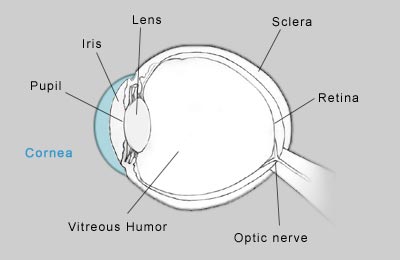 |
| Light first passes through the cornea,
the eye's window. Light rays bend as they pass
through the curved surface. |
The cornea is the outermost layer of the eye -- the
"window", through which light enters the eye. Protective
and transparent, the cornea is the primary refracting
(light-bending) component in the eye, providing about 75
percent of the focus. The rounded surface bends light as
it passes into the eye.
The cornea has no blood vessels for nourishment. It
receives oxygen from the air when the eye is open, and
from tiny blood vessels that line the inside of the
eyelid when the eye is closed. It is also nourished and
cushioned from inside the eye by a watery liquid called
the aqueous humor aqueous humor, which is produced by
and flows from the iris.
Sources
Cassel, G. Billig. The Eye Book: A Complete Guide to
Eye Disorders and Health. Baltimore, MA: Johns
Hopkins University Press, 1988.
Collins, J.F. Your Eyes: An Owner's Guide.
Englewood Cliffs, NJ: Prentice Hall, 1995.
D'Alonzo, T.L. Your Eyes: A Comprehensive Look at the
Understanding and Treatment of Vision Problems.
Clifton Heights, PA: Avanti Publishing, 1991.
Eden, J. The Physician's Guide to Cataracts,
Glaucoma, and Other Eye Problems. New York, NY:
Consumer Reports Books, A Division of Consumers Union
Yonkers, 1992.
Schuman, B.N. The Human Eye. New York, NY:
Atheneum, 1986.
Adler, R., Adler, I. Your Eyes. New York, NY: The
John Day Company, 1992.
Begbie, G.H. Seeing and the Eye: an Introduction to
Vision. Garden City, NY: National History Press,
1996.
Cohen, N.S. Out of Sight Into Vision: There is More
to Good Vision Than Reading the Fine Print. Toronto,
Canada: Collier Macmillan Canada, 1997.
Kwiko, M.L. Eyes. Toronto, Canada: Key Porter
Books, 1994.
Rainwater, J. Vision: How, Why, and What We See.
New York, NY: Golden Press, 1992.
|